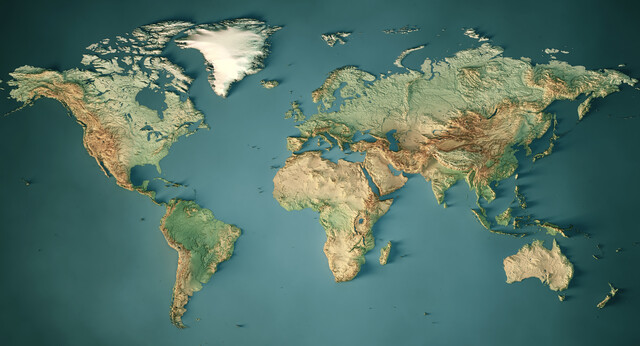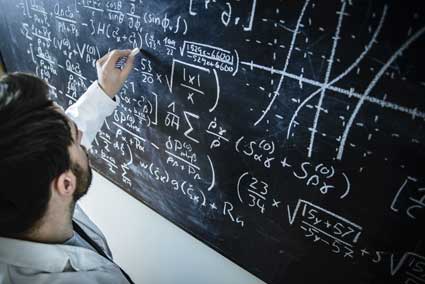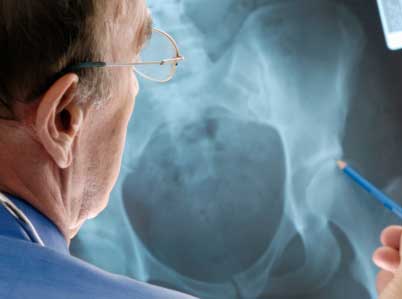When dealing with physics and attempting to interweave the workings of gravity, we need to expand our idea of gravity to encompass not only the phenomenon of falling, but also an understanding of its cause, source, rate of speed (motion), and its relationship with outside objects and the environment.
Sir Isaac Newton is the historically renowned British scientist and mathematician who formulated laws pertaining to both motion and gravity.
Newton determined gravity to be one of the universal forces of nature. He discovered it to be a force of attraction associated with all matter. This force is dependent upon the mass of the respective objects.
By our untrained eye alone, we cannot see gravity at work. It is only when one of the objects is immensely large (like the Earth) that we are able to bear witness to its gravitational pull.
Using mathematical equations, Newton formulated his Law of Universal Gravitation, which states:
"Gravity is strongest between two very massive objects, and gets much weaker as these objects get further apart."
B. Escape Velocity
With his original formula, Newton delineated the inner workings of the law, such as what he referred to as escape velocity, the velocity an object needs to achieve in order to escape the gravitational pull of another object. The escape velocity of an object can be found by using Newton's Law of Gravitation.
Consider for a moment black holes. When applying the concept of escape velocity to these fascinating structures, we find that because they are so very small and dense, the escape velocity is equal to the speed of light. Hence, only light escapes the dark abyss of a black hole.
C. Force of Gravity
The term force of gravity refers to the pull that exists between objects and earth. As humans we experience this force; it is what keeps our feet firmly planted on the ground instead of floating around in space. As we jump upwards, the same force applies. Rising up, the force of gravity slows us down, yet speeds us up again as our feet come back towards the ground. This force is called acceleration. We call this phenomenon "acceleration of gravity (g)." This is the acceleration experienced by an object when there are no other outside forces acting upon it.
Interestingly, the acceleration value for all objects is exactly the same, regardless of their individual mass.
D. Friction
The study of friction is known as tribology.
Friction is the byproduct of atomic and molecular forces interacting when surfaces come in contact with one another. For example, friction occurs when you walk on carpet with your bare feet or through a fluid medium (water, air, and so forth).
Friction is considered to be a resistance type of force that acts upon bodies that tend to oppose and (or) dampen out motion.
Essentially, two types of friction exist:
1. The Static Force of friction (fs). The force of friction between two objects when there is no motion.
2. The Kinetic Force of friction (fk). The force of friction between two objects when there is motion.
Friction is usually distinguished as being either static friction (the opposing frictional force as a body goes from rest to motion) or kinetic friction (the frictional force that tends to slow down a body in motion). In comparison, static friction is greater than kinetic friction.
The force attributed to kinetic friction tends to be proportional to the applied force. Therefore, a "coefficient of kinetic fiction" is defined as the ratio of frictional force to the normal force on the body.
In kinetic friction, there are sub-divisions of friction: Sliding, Rolling, and Fluid Friction. Once again, if the object remains motionless then it is static.
Sliding Friction. This occurs when two solid objects come into contact with one another and an outside force is applied which slides one of the objects into the other. Equations indicative of sliding friction are expressed with F as the force exerting resistance against the object and Fr as the force of friction.
Sliding Friction. Causes
The causes of sliding friction can include a rough surface, a molecular attraction, adhesion between the materials, or deformation resistance (as is the case with soft materials).
Once the wheel beings to roll, a resistive force (rolling friction) on the other surface slows the wheel's motion.
Should a force be applied, albeit not great enough to overtake the static force of friction, the wheel will start to roll. Should the force prove to be greater than the static resistance, eventually the wheel will slide or spin. And, though it will still roll, it will do so at a reduced rate of speed.
A demonstration of this concept can be seen by trying to get a car to accelerate on a slick, wet patch of concrete. Pushing on the accelerator pedal too hard only serves to spin the wheels so that, rather than the car moving forward, the wheels merely grind in place.
Once the wheel (think automobile) is set in motion (rolling), friction occurs at the point of contact with the other surface (in our example this would be the pavement), slowing the motion of the wheel. Typically, rolling friction is much less powerful than sliding friction. This is why a wheel can roll for some distance before slowing down and coming to a complete halt.
Rolling Friction. Causes
Similar to those of sliding friction, the causes of rolling friction include roughness of the surface, molecular attraction or adhesion between the materials, and deformation resistance as is the case with soft materials.
E. Fluid Friction.
When a solid object is in contact with a fluid (regardless of whether it is a liquid or a gas) and a force exerts pressure on either the object or the fluid, the result is a friction force that defies the motion. Examples of fluid friction include water flowing through a pipe, an airplane flying through the clouds or atmosphere, and oil lubricating an automobile engine parts.
F. Static and Kinetic Friction
If the viscosity (thickness) of the fluid is substantial, there may be zero movement on account of the presence of static friction. An example is trying to push oil up through a drill pump. At first, a great deal of pressure may be needed to cut through the static friction so that the oil can gush forth.
Going from static to kinetic friction, once the oil begins to move through the pump, the resistance shifts gears. Even though the oil may now be flowing, it will still be traveling at a slower speed than a fluid that has a low viscosity, like water.
Note: It is also possible for fluid friction to occur in cases where one fluid comes into contact with another fluid. This type of scenario is usually categorized as part of the field of Fluid Dynamics.
Causes of fluid friction include the effects of turbulence caused from surface roughness and deformities, molecular attraction, or adhesion between the materials, and deformation that exerts resistance against the fluid.
Summary




























